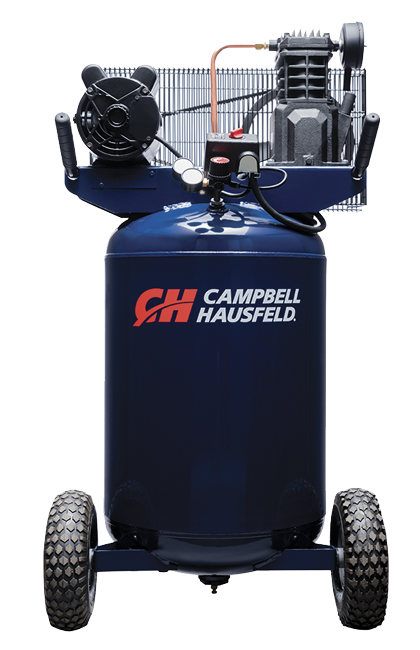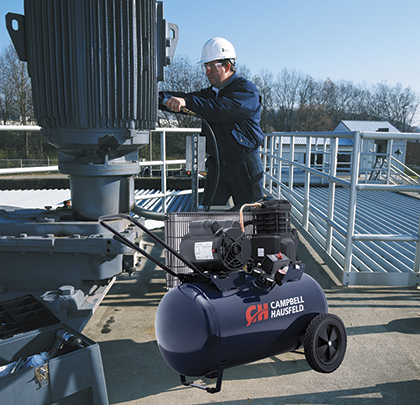Air compressors are important pieces of equipment on most jobsites—powering a wide variety of tools that help contractors get the job done. However, many contractors may wonder when it’s time to make the jump from a smaller portable compressor to a larger unit that provides higher air volume while still offering portability.
The decision is driven by the variety of needs encountered on the job. Key questions to consider when choosing a portable air compressor: What type of jobs will be completed? And, what tools will be used? Certain tasks—such as powering roofing or framing nailers, or sanding or air body saws—require higher air volume, which calls for a larger air compressor. The need for more air power also becomes an issue as work crews get larger and more workers use the same compressor.
As the tasks on a jobsite diversify or as crews become larger, it’s more likely that contractors will encounter the need for a professional-grade air compressor to help them power a wider variety of jobs. Portable air compressors—those that range from 8 to 30 gallons—offer great versatility for many applications.
CAPABILITIES OF LARGER UNITS
General contractors complete all kinds of projects; it could be a one-person job, or perhaps a large crew is needed to finish the task.
Some common tasks that may require a larger compressor that provides higher air flow include framing, roughing out rooms and basements, or roofing jobs. These tasks generally require the use of various types of powerful pneumatic tools—all of which require much more air power than smaller air compressors can provide.
Air compressors in the 8- to 30-gallon range typically offer air flow from 5 cfm to 15 cfm. It’s important to consider what types of pneumatic tools will be used, to ensure the compressor’s cfm rating meets the needs of the application. A key benefit to using a higher-capacity air compressor is the option of powering multiple air tools at once, which increases productivity.
Tank configuration is another factor to consider. The tank design can impact how easy it is to transport the compressor or move it around on the job. Wheelbarrow units are ideal for projects where there is rough, uneven ground, while portable 20- to 30-gallon compressors (either horizontal or vertical) are designed for concrete or more finished jobsites. Any of these units can get the job done: The contractor’s preference plays a key role in the final buying decision in many cases.
ELECTRIC OR GAS?
Another key choice in air compressor styles is gas or electric, and this decision is specific to the application. Most jobsites start out with no electricity, making it tough to power tools. In these situations, a gas-powered compressor is the only solution, and many contractors choose wheelbarrow-style units for greater portability on unfinished jobsites. One example is the CE2000 model from Campbell Hausfeld. This 9-gallon, 5.5 hp, gas-powered wheelbarrow air compressor delivers 10.2 cfm at 90 psi to power a wide variety of air tools.

Larger air compressors in the 8- to 30-gallon range typically offer air flow from 5 cfm to 15 cfm. In making the selection, consider what types of jobsite tools will be powered with the compressor, to ensure the cfm rating of the compressor can meet the needs of the job.
Once the job progresses to the point where electricity is available onsite, contractors typically switch to electric-powered units, which provide much quieter operation than gas-powered compressors. One example of a larger electric unit is the VT6358 air compressor from Campbell Hausfeld. This 30-gallon vertical unit provides quieter operation, 5.5 cfm and 2 hp. In addition, the dual-voltage motor can operate on 120V or 240V, providing versatility for more locations.
ADDITIONAL CONSIDERATIONS
Beyond the compressor’s air capacity, there are several other factors to consider when selecting the unit that is the most appropriate for your specific needs.
Durability: While price is a key factor in many purchasing decisions, durability is just as important—if not more important—for many contractors. Luckily, there are a variety of air compressors to choose from that will provide years of dependable, worry-free performance. Oil-lubed air compressors are the typical choice for the pro. While these units do require some routine maintenance, the components are designed to wear and be maintained versus having to buy a new unit. The average product life for an oil-lubed air compressor is at least 10 times that of a standard direct-drive unit. Some contractors get 20 years or more from one of these units. The upfront investment is more, but the longer product life helps provide a significant return on that investment.
Serviceability: Investing in a longer-life compressor will require routine maintenance that includes but is not limited to: changing the oil, air filters, and drive belts on the compressor pump or engine. It’s important to do some research and look for a compressor that offers ease of serviceability. Some manufacturers, for example, use common parts across their air compressor offerings, for easier part service, availability, and replacement.
CHOOSING THE RIGHT TOOL FOR THE JOB
Contractors complete a wide range of jobs, and it’s all about having the right tools on hand. While using a smaller hand-held air compressor can limit contractors to finishing work, taking the step up to a larger portable air compressor unit provides a higher air flow to power more tools. This opens up more jobs and provides greater versatility for contractors. ■
About the Author: Ben Echtenkamp is an engineering manager with Campbell Hausfeld. To learn more about Campbell Hausfeld’s compressors, visit www.campbellhausfeld.com.
_________________________________________________________________________
Modern Contractor Solutions, March 2017
Did you enjoy this article?
Subscribe to the FREE Digital Edition of Modern Contractor Solutions magazine.

Professional Portable Air Compressors


